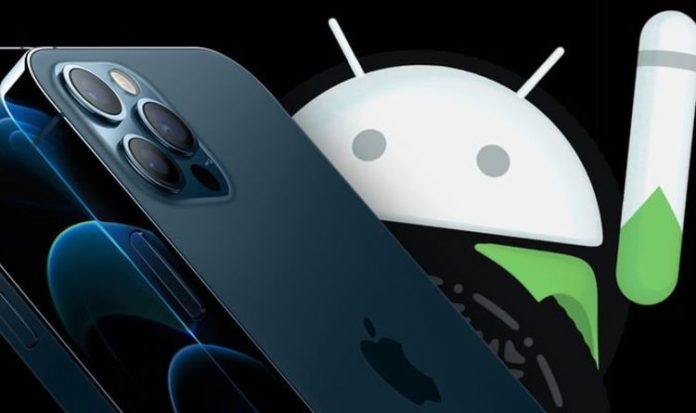Apple iPhone fans will always believe their smartphones are unbeatable and Android users will make similar claims about the devices tucked inside their pockets. The iPhone v Android war has been a long-fought battle but it seems the next generation of non-Apple call makers might not be able to keep pace with the latest advancements from the Cupertino-based tech firm.
The latest iPhone 12 range is, of course, powered by the new A14 Bionic processor and there’s little doubt that these brains beat the current range of Android phones. Apple made some big claims during its keynote back in October with the company boasting that the A14 Bionic is quicker and more efficient than ever with its CPU and GPU around 50 percent faster when compared to competing smartphone chips.
However, Apple may not have it all its own way with Qualcomm recently announcing its new Snapdragon 888 chip which will power many of the latest flagship Android devices launching in the coming months.
An 888-powered phone is yet to officially launch so it’s tough to know exactly how well these devices will perform when placed alongside the iPhone 12. Qualcomm has, however, released some benchmark results for its 888 brains and it seems that Apple may have the upper hand.
READ MORE: iPhone 12 Pro Max review: An Apple iPhone that’s truly worthy of its ‘Pro’ name
The results, which were first published by AnandTech, reveal that the Snapdragon 888 chip scored 1,135 in single-core tests and 3,794 in multi-core testing via Geekbench 5.
Place those figures alongside the iPhone 12 Pro and you can see why Apple might be feeling pretty smug. This A14-powered device scored 1,603 in single-core testing and 4,187 in multi-core testing which is a considerable difference between the 888.
That’s clearly great news for iPhone owners and a slight disappointment for those who prefer the freedom of Google’s Android operating system.
But before iPhone users start gloating too much this might not tell the whole story.
According to the team at AnandTech, while the Snapdragon 888 appears to lack the peak performance of Apple’s iPhone 12 it could still match its rival when being used day-to-day.
As the site explains. “While the Snapdragon 888 doesn’t look like it’ll match the peak performance scores of the A13 or A14 SoCs used in Apple’s iPhones, sustained performance will depend quite a bit on the power consumption of the chip. If this lands in at between 4 and 4.5W, then the majority of flagship Android phones in 2021 will likely be able to sustain this peak performance figure and allow Qualcomm to regain the mobile performance crown from Apple”
The fact that some Android devices often pack more RAM under the hood could also give them an advantage but we’ll have to wait and see how the 888 performs when the first devices arrive in stores over the coming months.
This next-generation chip certainly offers some big gains over its predecessors with Qualcomm revealing that the 888 generates up to a 25 percent uplift in overall CPU performance and its biggest performance leap yet when it comes to the GPU.
It promises 35 percent faster graphics rendering compared to the previous generation.
Along with this power boost, the 888 is also far more efficient meaning improved battery life for the devices that use it. It’s unclear exactly what the battery life gains will be exactly, but expect some serious longevity with the 2020 flagship smartphones when they launch.
And then there’s the 5G speeds with this latest chip technology able to beam downloads to devices at over 7Gbps – at that speed, you could download a full HD movie in a matter of seconds.
“Qualcomm’s history of breakthrough technology inventions has paved the way for our continued leadership in the premium-tier mobile segment,” said Alex Katouzian, senior vice president and general manager of mobile, compute and infrastructure, Qualcomm Technologies, Inc. “The new flagship Snapdragon 888 Mobile Platform will enable OEMs to further differentiate their devices and allows users to experience the latest cutting-edge mobile technologies.”




